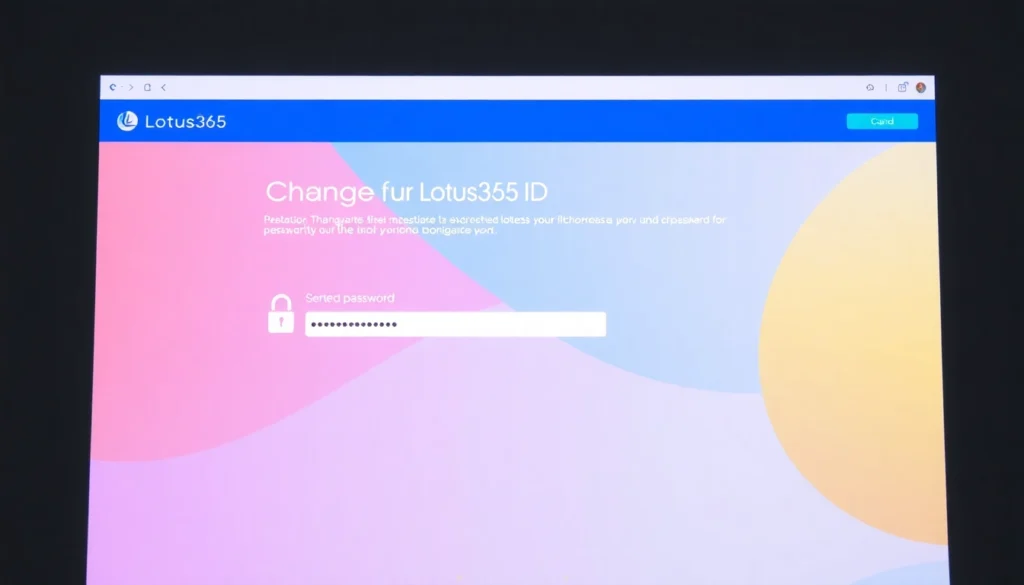Ensuring Secure Access: How to Change Your Lotus365 ID Password and Maintain Account Safety
In today’s digital-driven world, safeguarding your online accounts is paramount—especially when it involves sensitive data or financial transactions. If you are a user of the Lotus365 ID, understanding how to effectively manage and update your account credentials, particularly your password, is essential for maintaining your security and uninterrupted access. This comprehensive guide walks you through the importance of changing your Lotus365 ID password, detailed step-by-step instructions, and best practices to fortify your account against potential threats. Whether you’re new to Lotus365 or a seasoned user, mastering these security measures will ensure your account remains safe, private, and fully under your control.
Introduction to Lotus365 ID and Account Security
Understanding the importance of account security
Security in the digital age extends beyond mere password protection; it encompasses proactive management of your account credentials, vigilance against phishing attempts, and the use of multi-layered security features. Your Lotus365 ID serves as a gateway to various services—sports betting, casino games, and financial transactions—making it critical to guard it against unauthorized access. A compromised account can lead to financial loss, data theft, or unwanted exposure of personal information. Consequently, regularly updating your password, understanding how to change it, and employing other security best practices are vital components of your overall online safety strategy.
Overview of Lotus365 ID features and benefits
Lotus365 ID is designed to offer users a seamless and secure experience across multiple betting and gaming platforms. It provides advantages such as single sign-on access to sports betting, live casino games, and secure transaction handling—all accessible through one account. Additionally, Lotus365 prioritizes user privacy and transaction security, employing encryption and verification protocols. Over time, users have highlighted the platform’s ease of use, prompt customer support, and the ability to safeguard their gaming activities by managing their account credentials effectively. A focus on password security ensures that your account remains resilient against common cyber threats.
Common reasons to update or change your password
- Suspicion of unauthorized access or security breach
- Regular security maintenance recommended by the platform
- Exposure of credentials on phishing sites or suspicious communications
- Resetting password after a forgotten or compromised login
- Enhancing account security by selecting a stronger, more complex password
In summary, changing your Lotus365 ID password isn’t just a reactive step—it’s a proactive measure to protect your assets and personal data. Regular updates help prevent unauthorized access, especially when combined with other security practices like two-factor authentication (2FA).
Step-by-Step Process to Change Your Lotus365 ID Password
Logging into your Lotus365 account securely
Start by navigating to the official Lotus365 login page at https://www.lotus365.care. Enter your User ID and current password in the designated fields. Ensure you access the platform through a secure or private internet connection—preferably a trusted Wi-Fi network or a wired connection—to prevent intercepting your login details. Look for the padlock icon in your browser’s address bar, which confirms that the connection is encrypted. If you have forgotten your current password, proceed to the account recovery options below before attempting to change the password.
Navigating to the account settings page
Once logged in, locate the account or profile icon—typically situated at the top right corner of the dashboard. Click on it to reveal a dropdown menu or direct link labeled ‘Account Settings’ or ‘Profile Settings.’ Within this section, find the subsection dedicated to security settings or password management. Most platforms streamline this process, offering a dedicated ‘Change Password’ feature designed to facilitate quick and secure updates.
Using the ‘Change Password’ feature effectively
In the password change interface, you’ll generally be prompted to enter your current password for verification. Follow these steps carefully:
- Input your current password accurately.
- Enter your new password—make sure it complies with recommended security practices (discussed below).
- Re-enter the new password to confirm it.
Ensure that your new password meets complexity requirements to prevent easy guessing. Once you’ve verified your inputs, click the ‘Save’ or ‘Update’ button. A confirmation message will typically appear, indicating success. For added security, some platforms may ask you to verify your identity via email or SMS before finalizing the change.
Best Practices for Creating a Strong Password
Tips for choosing a complex yet memorable password
Creating a robust password involves balancing complexity and memorability. Effective strategies include:
- Using a mix of uppercase and lowercase letters, numbers, and special characters
- Making passwords at least 12-16 characters long
- Avoiding common words, phrases, or easily guessable information like birthdays or pet names
- Incorporating passphrases—sequences of random words or a memorable sentence with substitutions (e.g., “Tr!ckyD0g$Jump!s#7Fences”)
Phasing out predictable patterns significantly reduces the risk of brute-force attacks or credential stuffing attempts.
Leveraging password managers for safety
Managing multiple complex passwords can be daunting; hence, utilizing reputable password managers like LastPass, 1Password, or Dashlane is highly recommended. These tools securely store your passwords and generate strong, unique credentials for each platform, simplifying the process of maintaining varied, resilient passwords without the risk of forgetting them.
Avoiding common pitfalls in password creation
Common mistakes include reusing passwords across sites, choosing simplistic passwords like “password123,” or sharing passwords via unencrypted channels. Always create unique passwords for each account and avoid writing them down in insecure locations. Regularly rotating passwords (every three to six months) reinforces security and minimizes risk exposure from potential breaches.
Troubleshooting Common Issues During Password Change
Recovering access if you forget your current password
If you cannot remember your existing password, use the ‘Forgot Password’ or ‘Reset Password’ feature on the login page. Typically, you will need to provide your registered email address or phone number to receive a verification code or reset link. Follow the instructions to create a new password without compromising account security.
Dealing with account lockouts or verification errors
Repeated failed login attempts may temporarily lock your account for security reasons. In such cases, wait for the lockout period to expire or contact Lotus365 support for assistance. Ensure your device’s date and time settings are correct, as discrepancies can cause verification issues. If you encounter persistent errors, verifying your account via support channels ensures proper recovery procedures are followed.
Contacting support for persistent issues
For unresolved technical problems, reach out through official support avenues provided on the Lotus365 website. Provide detailed information about your issue—such as error messages and steps you’ve taken—to expedite resolution. Do not share your password or sensitive details via email or messaging platforms, only communicate through verified support forms or official contact channels.
Maintaining Long-term Account Security
Regularly updating your Lotus365 ID password
Changing your password periodically—every three to six months—is a security best practice that minimizes long-term risks. Set reminders or leverage password manager alerts to prompt routine updates, further reducing vulnerability to breaches.
Enabling two-factor authentication (2FA)
Adding 2FA provides an extra layer of security beyond passwords. Lotus365 supports this feature through SMS codes, authenticator apps, or email verification. Once enabled, even if your password is compromised, malicious actors will need the second factor to access your account, dramatically increasing your security posture.
Monitoring account activity for suspicious actions
Regularly review your account activity logs for unfamiliar logins, transactions, or changes. Most platforms provide activity history features—use them to detect anomalies early. If suspicious activity is found, immediately change your password, disable 2FA if necessary, and notify support to secure your account.


